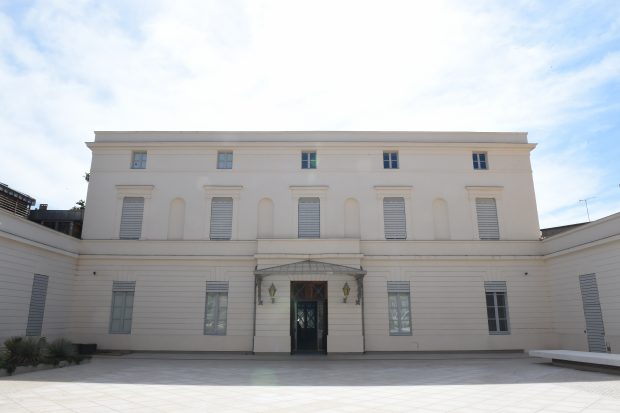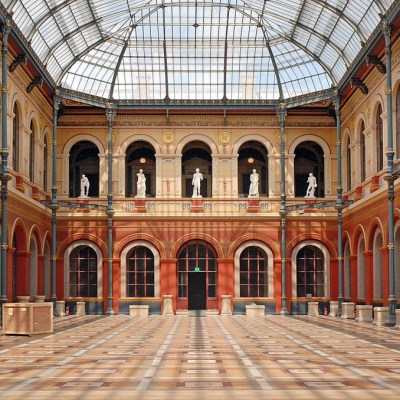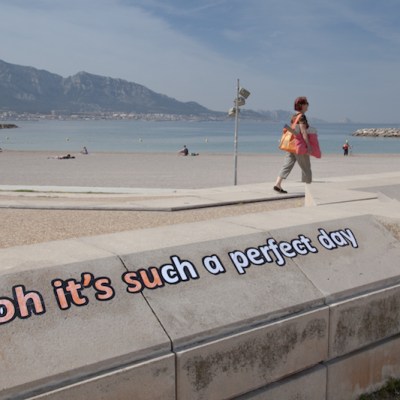The Montpellier-born painter François-Xavier Fabre studied under Jacques-Louis David and, following in his teacher’s footsteps, went on to win the Prix de Rome in 1787. When the French Revolution began Fabre, a steadfast monarchist, moved to Florence. While he continued to paint in Italy, mostly producing popular society portraits and landscapes, Fabre also began to collect art in earnest, purchasing work by his French contemporaries as well as 16th- and 17th-century Italian drawings and paintings. Today Fabre is best known as a collector, rather than a painter – thanks primarily to his decision in 1825 to donate his entire collection to a small municipal museum founded in his hometown of Montpellier 23 years earlier. The museum was renamed the Musée Fabre in his honour.
Musée Fabre, Montpellier. © Ville de Montpellier

Over the years the shape and character of the museum’s collection has been formed by a number of substantial gifts from individual artists, patrons, and collectors. In 1868 Alfred Bruyas donated his entire collection of works by the most important painters of his time, including around 40 portraits of Bruyas himself. Today depictions of the patron’s distinctive face, his sharp cheekbones, and long flame-coloured beard, line the 19th-century galleries’ walls, in works by noted artists from Eugène Delacroix to Gustave Courbet, who was a close friend of Bruyas. A decade ago the museum’s modern art collection was transformed with the unveiling of a spectacular new suite of rooms specially designed to house a gift of 20 major works by the French painter Pierre Soulages. For many of its modern-day visitors, the Soulages collection is the museum’s crowning jewel.
The Meeting (1854), by Gustave Courbet depicts the painter (right) and his patron, Alfred Bruyas (centre). Musée Fabre

Until recently the Musée Fabre was Montpellier’s only major space devoted to the fine arts. But last year the city appointed star curator and writer Nicolas Bourriaud to helm an ambitious multi-site project, MoCo – Montpellier Contemporain. Montpellier’s new contemporary art institution will consist of three separate elements: a fine art school; La Panacée, an exhibition centre for emerging artists (a modestly sized site which opened in 2013 and was formerly dedicated to digital arts); and the main venue, a public art museum. The first exhibitions under Bourriaud’s direction opened at La Panacée this January, and the second, bigger centre, which will be housed in an 18th-century building, is scheduled to open in September 2019.
This building, named the Hôtel de Montcalm, was previously intended as the site of a museum devoted to Algerian history; Montpellier’s new mayor Philippe Saurel quickly scrapped the project when he assumed office in 2014, declaring the region in need of a ‘contemporary art centre to match its ambitions’. The arts seem to be a high priority for Saurel, who has approved a huge culture budget for Montpellier – second in France only to that of Paris. The appointment of Bourriaud, writer of the seminal text Relational Aesthetics and co-founder of the Palais de Tokyo in Paris, could not have come cheap. Converting the historic building of the Hôtel de Montcalm into a brand-new contemporary art museum is also going to be a major undertaking. During a tour of the building – currently a building site – Bourriaud spoke about his plans to transform its architecture. He also revealed that he is currently in negotiations to take over an adjacent spot that stands between the Hôtel de Montcalm and Montpellier train station, with a future extension for the museum in mind.
MOCO, L’Hôtel Montcalm. © Ville de Montpellier

As a statement of the city’s global ambitions, the MoCo project is a familiar strategy: a shiny new museum placing Montpellier on the international culture map. What’s unusual about MoCo, however, is the specificity of the concept that Bourriaud has dreamt up. The museum itself will have no collection, instead taking ‘collections’ as its theme. All exhibitions will draw from specific existing collections of art, public and private, from around the world. The idea of a research centre devoted to the study of such collections is also being considered. For Bourriaud, this particular focus is ‘something which is missing from the scene’ at the moment; he has no interest in delivering more of the same.
Also promising is the knowledge that MoCo’s inspiration came not from the international network of Louvres and Guggenheims, but from Montpellier’s own Musée Fabre. It was Bourriaud’s discovery of the history behind the museum’s idiosyncratic collection that gave him his ‘light bulb’ moment. Thus, by the end of this decade Montpellier will be home to two significant institutions of art, each providing visitors with a different insight into the important role that collections – and collectors themselves – can play in forming the history and texture of our museums.


